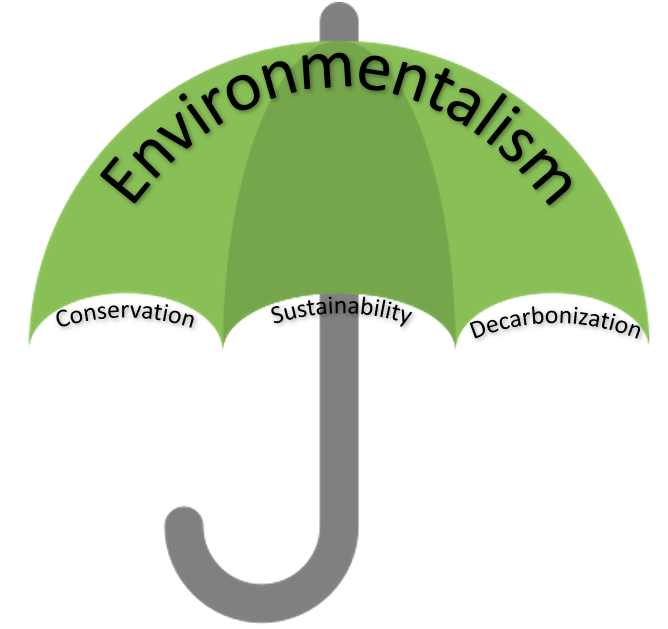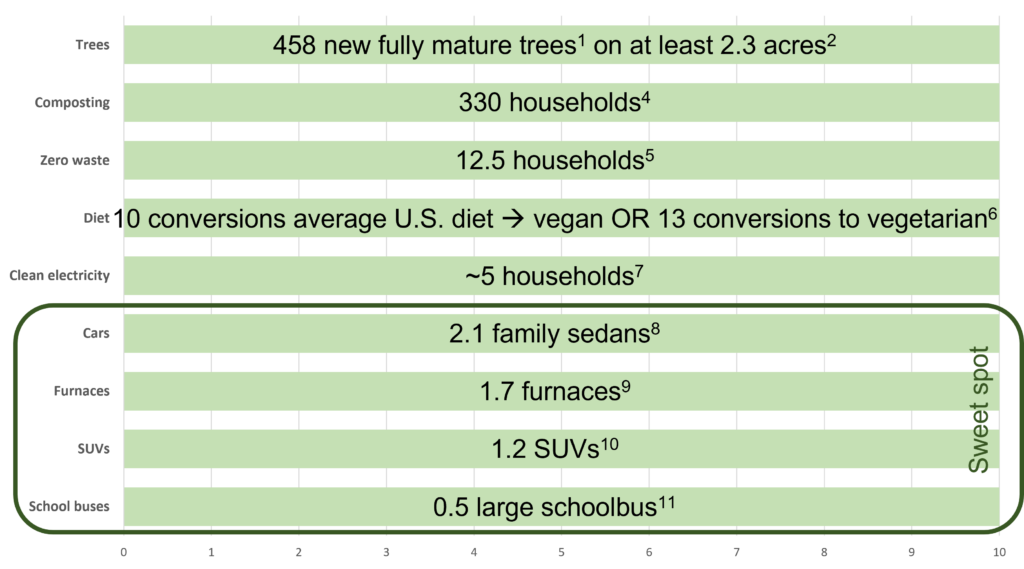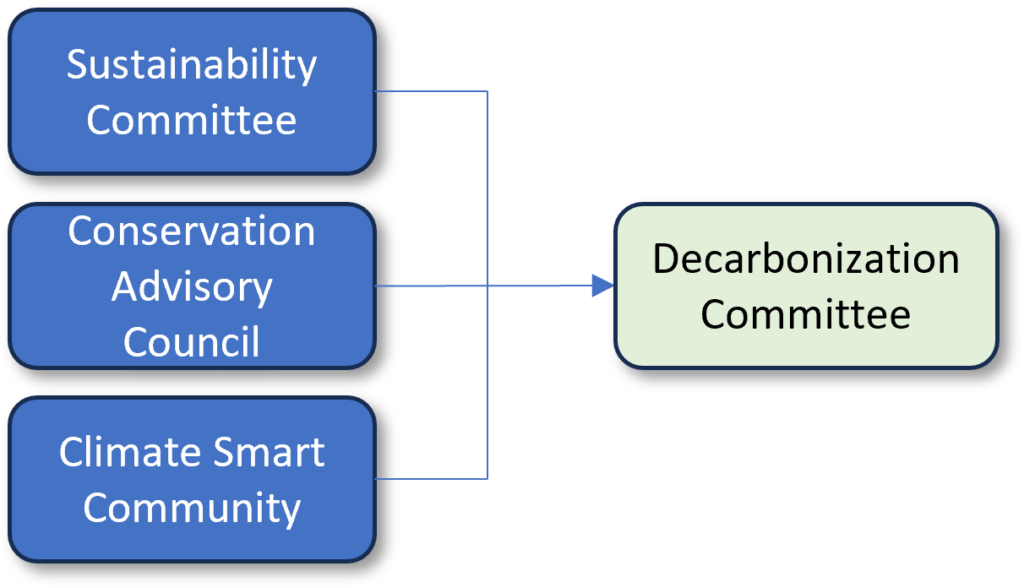
Conservation vs. Sustainability vs. Decarbonization
By: Chandu Visweswariah
Every Town and Village has a potpourri of governmental environmental organizations like a Sustainability Committee, a Conservation Advisory Council and a Climate Smart Community. There’s even a NY State Association of Conservation Commissions. There’s also typically a grab bag of local and national environmental non-governmental organizations (NGOs). With all this fervor and well-meaning effort, you would think we’d be decarbonizing at a rapid clip! Sadly, this is not the case. The planet faces a Titanic moment, and all we are collectively doing is busily rearranging deck chairs. Why is that, and what can we do about it?
First, let’s back up the statement that decarbonization is not progressing sufficiently rapidly. Greenhouse Gas (GHG) emissions are unabated and continuing to grow globally while mankind continues on its suicide march. CO2 in the atmosphere continues to increase, recently storming past 420 parts per million (the safe limit is 350 ppm). Sales of fossil fuels still haven’t reached their peak. Most painfully, we all see well-meaning environmentally-minded neighbors and communities continuing to invest in gas guzzlers and oil or gas furnaces. We also see School Districts continuing to invest in fossil fuel buses. Even as we are battered by forest fires, air quality crises, floods and hurricanes, we realize that net zero by 2040 is a pipe dream and decarbonization is not yet top of mind.
The lack of results is due to a jumble of (well-meaning) activities and semantics. What is the difference between Conservation, Sustainability and Decarbonization? Don’t we all care about the environment? These activities have areas of overlap, and of course they all pursue important goals. However, the way the words are used and interpreted is quite different. And the way they are implemented by various organizations is even more varied. And when we have organizations whose core mission is “Sustainability” or “Conservation,” we can’t seem to agree on priorities and how to act in the face of conflicting requirements. How do we obtain meaningful and tangible benefits from these efforts?
Conservation and sustainability are centuries-old movements, harking back at least to John Muir and his love of the natural world. Decarbonization, on the other hand, is relatively new. We crossed 350 parts per million of CO2 in the atmosphere (the safe limit) in May 1986, around the time that Congress first heard testimony about climate change, so at best it is 40 years old, and in practice much less. (The fossil fuel industry, on the other hand, has known about the harms from their products’ emissions for 60 years.)
Conservation Councils are focused on nurturing the natural environment. They strive to protect land and water. Of primary concern to them are green spaces, open spaces, preserving trees, ecological diversity, land use and keeping streams and rivers clean. By definition, “conservation” means that we conserve that which we already have, so these councils try to conserve our open spaces, our bodies of water and our native species of flora and fauna. Good work done by good people, many of them volunteers! “But broad decarbonization should now be the top priority of any Conservation Council,” I think to myself!
Sustainability Committees “sustain” our way of life. They are typically concerned about recycling, waste reduction, composting, plastics in our waterways, energy efficiency, etc. At its finest, sustainability implies a fully circular economy in which all materials are reused and repurposed with zero waste (and therefore lower emissions from landfills and incinerators). More recently, in a glimmer of hope, NYSERDA has been encouraging EV and heat pump adoption through its Climate Smart Communities Program.
Again, good work done by good people, many volunteers! “But broad decarbonization should now be the top priority of any Sustainability Committee,” I think to myself!
Decarbonization is very specific and easily measurable. It means reduction of greenhouse gas (GHG) emissions, which are typically measured in metric tons of CO2-equivalent or CO2e. Globally, we emit just shy of 60 billion metric tons of GHG annually, and we need to get that to net zero by 2040. Climate change is undoubtedly the existential crisis of our lifetime and should therefore enjoy the highest priority when considering inevitable tradeoffs. In other words, the top priority of any environmental body should be decarbonization. As long as we are in crisis mode, environmentalism equals decarbonization!

My previous blog talked about the effort involved in reducing 10 tons of CO2e, which amounts to about 20% of the annual emissions of a typical household here in Westchester County. There are very clearly “heavy hitters” like transportation and building energy which together account for the bulk of GHG emissions. The true spirit of decarbonization is to go after these “big hitters” and spur the transition to Electric Vehicles (EVs), heat pumps and renewable electricity. We have the necessary solutions; we need to scale them rapidly. As the saying goes, “Electrify everything and get the electricity from clean sources.” Can we unite all our efforts towards this mission?
Those of us who have done this for a while know that discussions about heavy hitters are uphill and quickly get technical (or “nerdy” or “gorpy”). The suggested decarbonization steps could involve significant investment and are often not easy to implement. For many people, they represent a stark change from the familiar fossil-soaked world they’ve known. Worrying about EV charging infrastructure or retrofitting a home with heat pumps are significant steps that require careful thought and budgeting. However, these are the “big hitter” actions that will prevent the worst impacts of climate change.
Then there are the so-called “small hitter” actions. While they are beneficial (in that they contribute to conservation or sustainability goals), they don’t move the decarbonization needle significantly in our crisis situation. Everything from planting native gardens, pollinator pathways, composting, recycling, diet changes, landscaping techniques, waste reduction, etc. From a decarbonization perspective, they distract from the focus on “heavy hitters.” If the effort that goes into these activities was redirected to “heavy hitter” objectives, we would decarbonize at a more rapid pace.
On the non-profit or Non-Governmental Organization (NGO) side, the story is not much better. Very few non-profits are broad-based decarbonization platforms. Notably, a plethora of decarbonizing organizations have overtaken the more traditional “environmental movement” that had focused on conservation goals like Sierra Club, Audubon Society, Natural Resources Defense Council and World
Wildlife Federation. We now see decarbonization as a priority for movements like Climate Reality Project, Fridays for Future, Sunrise Movement, Sane Energy, NY Renews and League of Conservation Voters. Sadly, most well-established environmental organizations don’t even mention decarbonization in their vision and mission statements, and several do so in name only. Unfortunately, for the most part, their emphasis is once again on “small hitter” actions, resulting in easier campaigns that concomitantly achieve very little decarbonization.
Any time a local decarbonization project or campaign is considered, it inevitably comes with tradeoffs. In recent memory, a large solar farm was proposed nearby, for which about 600 trees would have to be felled. Our carbon analysis showed that it was a huge win for decarbonization, but there was no clear local voice on carbon benefits. (The permit application was ultimately withdrawn due to vehement opposition by neighbors and community members.) Thus, an opportunity to discuss our carbon crisis and how desperately we need such solar farms was lost and we sorely lacked an authoritative and knowledgeable voice.
School districts all over the nation are grappling with electrifying their bus fleets. Here again, local environmental organizations can play a part if they speak up with a unified voice about the carbon benefits, health benefits and savings in fuel and maintenance. Instead, school bus electrification is proceeding at best in fits and starts with room for all kinds of fear, uncertainty and doubt (“Can the buses be parked outdoors?” “Will they climb hills?” “Do they work in winter?”) and the topic of school bus electrification has been politicized and considered “controversial.” A complete failure of local environmental organizations of all stripes!
Methane is a very potent greenhouse gas when released unburned into the atmosphere. Hence, fracked gas has no role in our society, not even as a “bridge” to a clean-energy future. Unfortunately, local environmental organizations have a mixed track record in opposing gas, and many have done irreparable harm by facilitating the growth of natural gas as a clean-burning fuel.
It is truly dispiriting to see this semantic confusion and lack of urgency in dealing head-on with the climate crisis and to witness all these well-meaning organizations under-perform. Why is such a huge amount of effort producing so little? How do we fix this? Nobody wants to toil away with no tangible results.
[Author’s note: this was the end of the original blog. However, seeing as I ended with a rhetorical question, I then wrote a few more paragraphs to suggest a solution, while being mindful that the proposed solution may require an amendment of NY State laws.]
Let me offer four simple actions to improve the situation:
- Merge Conservation Advisory Councils and Sustainability Committees and Climate Smart Communities to create a single Decarbonization Committee in each Town or Village or City.
- Measure the performance of these committees by quantifying emissions reductions and celebrate those who achieve the most tons of CO2e reduction. This is the only way to make sure that efforts are calibrated and poured into those activities that yield the most decarbonization. After all, if that is our existential crisis, do we not owe it to ourselves to focus on it the most? And should we not do so in a systematic and quantified manner?
- Expand the scope of decarbonization from just municipal activities to a community-wide campaign.
- Build rich partnerships between these Decarbonization Committees and broad decarbonization non-profits such as CURE100, as well as with local businesses operating in the decarbonizing space (everything from EV dealers, heat pump installers, solar installers, E-bike shops, low-waste businesses, ESG investment advisors and the like).

The benefits would be numerous. For one thing, it would make the goal crystal clear and objective. You can only reduce that which you measure rigorously.
A unified committee would correctly deal with priority conflicts when decarbonization and conservation goals clash.
Opposing expansion of natural gas and pipelines thereof would be a natural outcome of such a unified committee.
A unified committee can serve an advisory role in all local decisions including the library, the School District, municipal facilities, as well as the residential and commercial sector.
Once we have such a knowledgeable committee, its benefits can be felt community-wide instead of just focusing on municipal activities and government-owned facilities. Such a respected local voice focused on decarbonization is sorely missing.
We need rapid grassroots decarbonization and systematic eschewing of fossil fuels – this is not happening fast enough or effectively enough. A single well-partnered decarbonization committee in each municipality would be a good way to focus the community on decarbonization goals instead of the distracted and discombobulated approach we see today.
Mayors, county executives, legislators: Anyone up for a pilot project?

